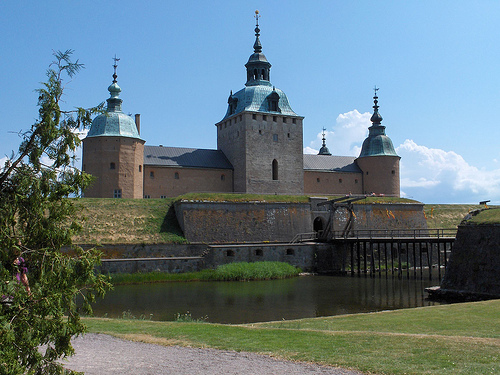

Location: Kalmar, Småland Map
Constructed: 12th- 16th century
Phone: 46 480 451490
Giftshop: 46
480 451491
Fax: 46 480 451499
The Letter of Union (July 20th, 1397)
Construction of Kalmar Castle was started here on the orders of Magnus III of Sweden Ladulås in 1280's. Initially Kalmar Castle consisted only of a single tower at the defensive position over medieval harbour. The castle of Kalmar is famous for Kalmar Union that was held on July 20th, 1397 under leadership of Queen Margaret I of Denmark. Later it was increased in size and complexity during reign of Vasa kings Erik XIV and Johan III the castle was build as a Renaissance Palace for Swedish kings. Norway, Sweden and Denmark were unified with this historic document.
During the 12th century a defensive tower was built on the
shores of the Kalmar Strait with a small harbor. At the end of the thirteenth century King Magnus Ladulås had
already built a new fortress with a wall, rounded corner towers and
two square booths surrounding the original tower. Located near the
medieval port of Kalmar, since its initial construction in the
twelfth century as a fortified tower played a crucial role in the
history of Sweden.
One of the most important political events in Scandinavia took place
at Kalmar Castle in 1397, when the Kalmar Union was formed - a union
of Denmark, Norway and Sweden - organized by Queen Margaret I of
Denmark. During the rebellion of Sweden against Denmark in 1520, the
fortress was commanded by Anna Eriksdotter (Bielke), who upon the
death of his spouse, Johan Månsson Dag och Natt, in the midst of the
rebellion, took control of their fiefs and defended Kalmar against
Denmark.
Kalmar fortress was improved during the sixteenth century under the
leadership of King Gustav I and his sons then kings Eric XIV and
John III, who converted the medieval fortress into a castle of a
Renaissance architectural style. The castle of Kalmar suffered serious damage
during the Kalmar War from 1611 to 1613 and was severely damaged by
a fire in 1642. Repairs were started, but from the end of the 17th
century the castle fell into disrepair.